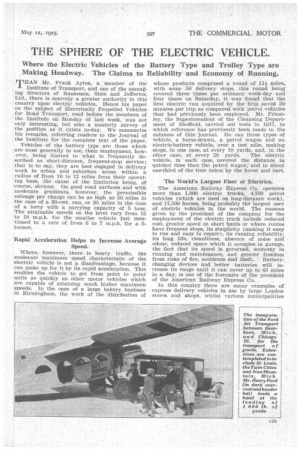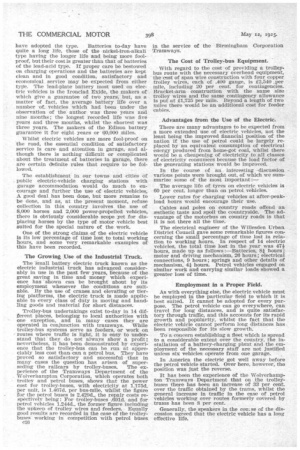THE SPHERE OF THE ELECTRIC VEHICLE.
Page 9

Page 10

If you've noticed an error in this article please click here to report it so we can fix it.
Where the Electric Vehicles of the Battery Type and Trolley Type are Making Headway. The Claims to Reliability and Economy of Running.
THAN Mr. Frank Ayton, a member of the Institute of Transport, and one of the =making directors of Ransomes, Sims and Jefferies, Ltd., there is scarcely a greater authority in this country upon electric vehicles. Hence his paper on the subject of Electrically Propelled Vehicles for Road Transport, read before the members of the Institute on Monday of last week, was not only interesting, but also a masterly survey of the position as it exists to-day. We summarize his remarks, referring readers to the Journal of the Institute for the complete text of the paper.
Vehicles of the battery type are those which are most generally in use, their employment, however, being limited to what is frequently described as short-distance, frequent-stop service; that is to say, they are best engaged in delivery work in urban and suburban areas within a radius of from 10 to 12 miles from their operating base, the cause of the limitation being, of course, obvious. On good road surfaces and with moderate gradients, however, the permissible mileage per charge can be as high as 50 miles in the case of a 30-cwt. van, or 35 miles in the case of a lorry with a carrying capacity of 5 tons. The attainable speeds on the level vary from 15 to 18 m.p.h. for the smaller vehicle just mentioned to a rate of from 6 to 7 m.p.h. for a 5tonner.
Rapid Acceleration Helps to Increase Average Speed.
Where, however, there is heavy traffic, the moderate maximum speed characteristic of the electric vehicle is not a disadvantage, because it can make up for it by its rapid acceleration. This enables the vehicle to get from point to point quite as quickly as other motor vehicles which are capable of attaining much higher maximum speeds. In the case of a large bakery business in Birmingham, the work of the distribution of whose products comprised a round of 114, miles, with some 50 delivery stops, this round being covered three times per ordinary week-day and four times on Saturday, it was found that the first electric van acquired by the firth saved 30 minutes per trip as compared with petrol vehicles that had previously been employed. Mr. Priestley, the Superintendent of the Cleansing Department of Sheffield, carried out tests in 1917, to which reference has previously been made in the columns of this journal. He ran three types of vehicle, a horse-drawn, a petrol wagon and an electric-battery vehicle, over a test mile, making stops, in one case, at every 10 yards, and, in the other ease, at every 20 yards. The electric vehicle, in each case, covered the distance in quicker time than the petrol wagon, and in about one-third of the time taken by the horse and Cart.
The World's Largest Fleet of Electrics.
The American Railway Express Co. operates more than 1,800 electric trucks, 4,700 petrol vehicles (which are used on long-distance work), and 17,500 horses, being probably the largest user of electric vehicles in the world. The reasons given by the president of the company for the employment of the electric truck include reduced cost, greater speed on short hauls or where routes have frequent stops, its simplicity (making it easy to run and easy to repair), its running reliability, its long life, cleanliness, absence of noise and odour, reduced space which it occupies in garage, the fact that its speed is governed, economy in running and maintenance, and greater freedom from risks of fire, accidents and theft. Batterychanging devices and better batteries will increase its range until it can cover up to 65 miles in a day, is one of the forecasts of the president of the American Railway Express Co.
In this country there are many examples of express delivery vehicles in use by large London stores and shops, whilst various municipalities have adopted the type. Batteries to-day have quite a long life, those of the nickel-iron-alkali type having the longer life and being more foolproof, but their cost is greater than that of batteries of the lead-acid type. If proper care be bestowed on charging operations and the batteries are kept clean and in good condition, satisfactory and economical service may be expected from either type. The lead-plate battery most used on electric vehicles is the Ironclad Exide, the makers of which give a guarantee of two years, but, as a matter of fact, the average battery life over a number of, vehicles which had been under the observation of the author was three years and nine months ; the longest recorded life was five years and three months, whilst the shortest was three years. The makers of the Edison battery guarantee it for eight years or 60,000 miles.
Whilst electric vehicles are more fool-proof on the road, the essential condition of satisfactory service is care and attention in garage, and although there is nothing difficult or complicated about the treatment of batteries in garage, there are certain clIelinite rules that require to be followed.
The establishment in our towns and cities of public electric-vehicle charging stations with garage accommodation would do much to encourage and further the use of electric vehicles, A good deal has been done, but more remains to be done, and as, at the present moment, refuse collection in this country involves the use of 8,000 horses and 2,000 power-propelled vehicles, there is obviously considerable scope yet for displacing horses by the type of motor -vehicle best suited for the special nature of the work.
One of the strong claims of the electric vehicle is its low percentage of time lost to total working hours, and some very remarkable examples of this have been recorded.
The Growing Use of the Industrial Truck.
The -Small battery electric truck known as the electric industrial truck has advanced considerably in use in the past few years, because of the great saving irk time and money which experience has 'shown can be brought about by its employment whenever the conditions are suitable. By the use of cranes and elevating or tiering platforms, the electric truck is made applicable to every class of duty in moving and handling goods and material for short distances.
Trolley-bus undertakings exist to-day in 14 different places, belonging to local authorities with one exception, and in many cases they are operated in conjunction with tramways. While trolley-bus systems serve as feeders, or work on routes where traffic is light, It is easy to understand that they do not always show a profit; nevertheless, It has been demonstrated by experience that the trolley-bus can be run at appreciably less cost than can a petrol bus. They have proved so satisfactory and successful that in many cases the question has arisen of super seding the railcars by trolley-buses. The experience of the Tramways Department of the Wolverhampton Corporation, which operates both trolley and petrol buses, shows that the power cost for trolley-buses, with electricity at 1.175d. per unit, is 1.467d. per bus-mile, whilst the figure for the petrol buses is 2.429d., the repair costs respectively being: For trolley-buses .691d. and for petrol vehicles 1.244c1., the former figure including the upkeep of trolley wires and feeders. Equally good results are recorded in the case of the trolleybuses working in competition with petrol buses_ er2e in the service of the Birmingham Corporation Tramways.
The Cost of Trolley-bus Equipment.
With regard to the cost of providing a trolley. bus route with the necessary overhead equipment, the cost of span wire construction with four copper trolley wires, each of .400 gauge, is £2,540 ,per mile, including 20 per cent. for Contingencies. Bracket-arm construction with the same size trolley wires and the same contingency allowance is put at £1,725 per mile. Beyond a length of two miles there would be an additional cost for feeder cables, Advantages from the Use of the Electric.
There are many advantages to be expected from a more extended use of electric vehicles, not the least being the improved financial position of the nation if the use of petrol could be largely replaced by an equivalent consumption of electrical energy produced from home-got coal, whilst there would be a cheapening of electricity to all classes of electricity consumers because the load factor of the generating stations would be improved.
in the course of an interesting -discussion various points were brought out, of which we summarize some of the most important:— The average life of tyres on electric vehicles is 60 per cent, longer than on petrol vehicles.
Lower rates for charging vehicles at after-peakload hours would encourage their use.
Cables and poles on country roads offend an aesthetic taste and spoil the countryside. The advantage of the motorbus on country roads is that it is not there all the time.
The electrical engineer of the Willesden Urban District Council gave some remarkable figures con; cerning the small percentage of time lost in relation to working hours. In respect of 14 electric vehicles, the total time lost in the year was 47i hours, made up as follows :—Batteries, 8i hours ; motor and driving mechanism, 26 hours; electrical connections, 9 hours ; springs and other details of mechanism, 4i hours. Petrol vehicles engaged on similar work and carrying similar loadsshowed a greater loss of time.
Employment in a Proper Field.
As with everything else, the electric vehicle must be employed in the particular field to which it is best suited. It cannot be adopted for every purpose. The petrol vehicle can go everywhere, can travel for long distances, and is quite satisfactory through traffic, and this accounts for its rapid growth and popularity, whilst the fact that the electric vehicle cannot perform long distances has been responsible for its slow growth.
To a concern establishing a fleet which is spread to a considerable extent over the country, the installation of a battery-charging plant and the employment of the necessary staff are not justified unless six vehicles operate from one garage.
In America the electric got well away before the petrol vehicle started. Over here, however; the position was lust the reverse.
It has been the experience of the Wolverhampton Tramways Department that on the trolleybuses there has been an increase of 33 per cent. over the traffic obtained by the trams, whilst the general increase in traffic in the case of petrol vehicles working over routes formerly covered by trams has been 8 per cent.
Generally, the speakers in the cou..se of the discussion agreed that the electric vehicle has a long effective life.
































